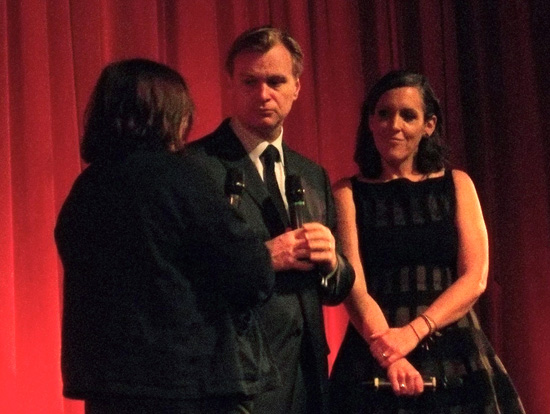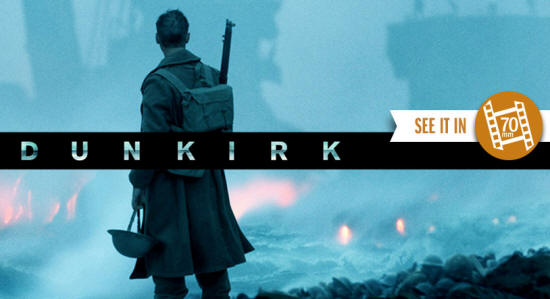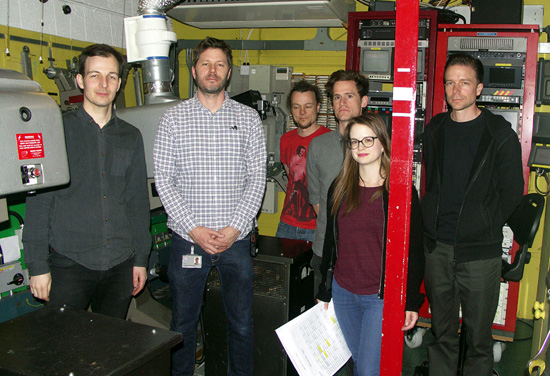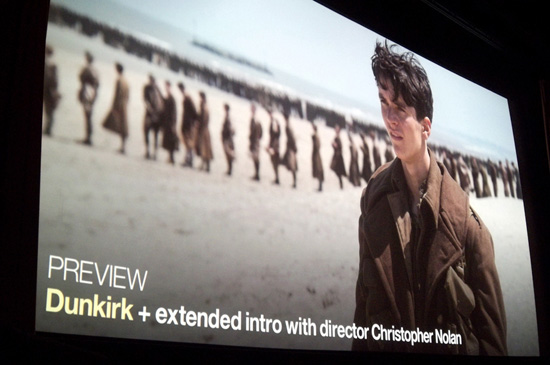“Dunkirk”: A personal first impression |
Read more at in70mm.com The 70mm Newsletter |
| Written and photographed by: Mark Trompeteler, London, UK | Date: 17.07.2017 |
 It
was through the thoughtfulness and generosity of a friend, and London
correspondent of in70mm.com, Mark Lyndon, that I found myself sitting beside
him in NFT1 at BFI Southbank on the evening of July 13th for a special 70mm
pre-release screening of “Dunkirk”, which was introduced by Christopher
Nolan himself. Nolan had just been ferried across the River Thames from the
red carpet world premičre at the Odeon Leicester Square, to which he
returned once the house lights had dimmed at our parallel universe
screening. This was a special screening running in tandem with the world
premičre on the other side of the river. Only Interstellar Nolan could be at
two screenings at the same time ! It
was through the thoughtfulness and generosity of a friend, and London
correspondent of in70mm.com, Mark Lyndon, that I found myself sitting beside
him in NFT1 at BFI Southbank on the evening of July 13th for a special 70mm
pre-release screening of “Dunkirk”, which was introduced by Christopher
Nolan himself. Nolan had just been ferried across the River Thames from the
red carpet world premičre at the Odeon Leicester Square, to which he
returned once the house lights had dimmed at our parallel universe
screening. This was a special screening running in tandem with the world
premičre on the other side of the river. Only Interstellar Nolan could be at
two screenings at the same time !Nolan and his wife, his producer Emma Thomas, came on stage and he talked about how he had been wanting to tell the story of Dunkirk on film for some time, and raise the awareness of this historical event globally. He described how it was a very critical moment in modern history that has had a profound impact on the western world and everything that has followed since. If Dunkirk had had another outcome we could all be living in a very different world today. Nolan also spoke of his love for the 70mm IMAX format, how it can create immersive experiences and convey intensity in story telling. Both his wife Emma, and him, extolled the merits of film generally including 35mm. Emma also recounted an anecdote about an embarrassing accident that occurred during the filming of “Dunkirk”. At one point a very very expensive 70mm IMAX camera was dropped into the sea and was submerged in salt water for a not insignificant time. After some careful flushing and drying out - it still worked ! Could that ever happen with a digital camera? |
More in 70mm reading: Report of the BFI "Dunkirk" preview "Dunkirk" Production Notes "Dunkirk" in the splendour of 7OMM Internet link: thr.com variety.com kodak.com nyt.com |
 I
found the official trailer to the film somewhat underwhelming, but in
contrast as soon as the film starts, and once you get into the action, the
film aims to overwhelm you. To me the screening of the 70mm film had that
softer, warmer, slightly glossy surface quality to the film image in
comparison to what I often feel is the crisper, precise, colder surface
quality of a digital image. The film was shown using the customised Kinoton
FP75E 35mm/70mm projectors in the NFT 1 projection box. To me the main issue
about this screening, and the film itself, was about some other important
factors. I
found the official trailer to the film somewhat underwhelming, but in
contrast as soon as the film starts, and once you get into the action, the
film aims to overwhelm you. To me the screening of the 70mm film had that
softer, warmer, slightly glossy surface quality to the film image in
comparison to what I often feel is the crisper, precise, colder surface
quality of a digital image. The film was shown using the customised Kinoton
FP75E 35mm/70mm projectors in the NFT 1 projection box. To me the main issue
about this screening, and the film itself, was about some other important
factors. Some of the very best moments of cinema are those moments where meaning, emotion, story and action are conveyed through solely the use of images, editing, music and non dialogue sound. This concept of “pure cinema” goes right back to the silent days. Think:- the pregnant mother crossing the moors, to the workhouse, in a storm, at the start of David Lean’s “Oliver Twist”; think The Blue Danube sequence in “2001”; some desert and other sequences in Lean’s “Lawrence of Arabia”. From its very beginning, to its closing moments, “Dunkirk” is pure cinema. Such “pure cinema” is at its very best when large wide screen aspect ratios are used as well the quality of high definition imagery. The film propels the audience into an immersive experience of what it might have felt like to be at Dunkirk. It uses very few titles to explain what is going on. Dialogue is sparse and not that essential to understanding what is happening, ( highly useful in a global cinema market. ) The use of images, editing, music and non dialogue sound, reign supreme. The ticking clock / pounding heart beat audio motif racks up the intensity throughout the film. In some ways it is like a giant audio visual mood piece or immersive evocation of war – do not expect lots of narrative or crucial essential dialogue. For an epic action film it is short, only 106 minutes in length, which is appropriate given it can come across as a mood piece. |
|
 It’s
use of intercutting between three different “viewpoints” of events is also
“pure cinema”. Three parallel stories are interwoven as the film progresses.
In the air – one hour - in the fighting life of a spitfire pilot is shown.
On the sea – one day – in the evacuation and rescue attempt of one of “the
little boats” is portrayed. On the land – one week – of the struggles of the
soldiers who are stranded on the beach and in need of rescue is evoked. The
intercutting between parallel stories and viewpoints surrounding a big event
is classic cinema. It’s
use of intercutting between three different “viewpoints” of events is also
“pure cinema”. Three parallel stories are interwoven as the film progresses.
In the air – one hour - in the fighting life of a spitfire pilot is shown.
On the sea – one day – in the evacuation and rescue attempt of one of “the
little boats” is portrayed. On the land – one week – of the struggles of the
soldiers who are stranded on the beach and in need of rescue is evoked. The
intercutting between parallel stories and viewpoints surrounding a big event
is classic cinema. It is always a little perverse to praise any imagery of war but there is some stunning cinematography and beautifully composed widescreen shots at times – with a camera that flies through the air, across the land, on and under the water, in a virtuoso piece of editing and immersive film making. I often find so many of the blockbuster, franchise, superhero and remake movies now in commercial cinema somewhat trite. Nolan by comparison, is now consistently producing intelligent epic films that do not patronise the audience, keep one eye on the imperative to provide entertainment and drama, and another eye on box office appeal. In this he is a worthy successor to such film makers as David Lean, Alfred Hitchcock, and Stanley Kubrick for our modern contemporary times. “Dunkirk” uses the old box office strategy of casting a pop icon as one of the actors. Also it handles the violence and destruction of war in such a manner that young teenagers can go and see this war film and not be traumatised by 15 or 18 certificate blood and gore. |
|
 In
“Dunkirk” Christopher Nolan has produced a mass audience, wide age
demographic, intelligent epic war film for modern times, - a war film for
the music video / Marvel / DC comics superhero / video games generation. I
was a little disappointed in the film at first viewing – after all the
advance hype – I was expecting something a little short of a masterpiece. It
is one the big pitfalls of so much hype and publicity in advance of a film’s
release. I am not a great fan of Hans Zimmer’s film music, at times I find
his cathedral like very long resonating loud chords a little overdone for my
taste. In
“Dunkirk” Christopher Nolan has produced a mass audience, wide age
demographic, intelligent epic war film for modern times, - a war film for
the music video / Marvel / DC comics superhero / video games generation. I
was a little disappointed in the film at first viewing – after all the
advance hype – I was expecting something a little short of a masterpiece. It
is one the big pitfalls of so much hype and publicity in advance of a film’s
release. I am not a great fan of Hans Zimmer’s film music, at times I find
his cathedral like very long resonating loud chords a little overdone for my
taste. However, this really is a “must see” film in 70mm if you are a 70mm enthusiast. This is a film I definitely want to see again. I know I enjoyed “Interstellar” far more on a second viewing. Christopher Nolan, has made a mass audience, wide age demographic, intelligent and immersive epic war film for modern times. In doing so he has updated and significantly furthered the cause of 70mm film, potentially to a very much wider age demographic than “The Hateful Eight” ever could, but also adds some always welcome quality product to global box office. |
|
| Go: back - top - back issues - news index Updated 22-01-25 |
